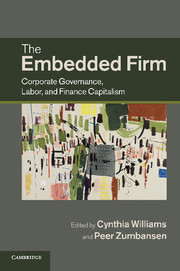Book contents
- Frontmatter
- Contents
- Figures
- Tables
- Contributors
- 1 Introduction: corporate governance after the ‘end of history’
- Part I Historical trajectories of business and regulation
- Part II New interests, new shareholder constellations, new landscapes
- Part III Labor’s evolution in the new economy
- 13 Labor and finance in the United States
- 14 The conflicting logic of markets and the management of production
- 15 Organizing workers globally
- 16 From governance to political economy
- Part IV The transnational embedded firm and the financial crisis
- Part V Conclusion
- Index
- References
13 - Labor and finance in the United States
from Part III - Labor’s evolution in the new economy
Published online by Cambridge University Press: 07 September 2011
- Frontmatter
- Contents
- Figures
- Tables
- Contributors
- 1 Introduction: corporate governance after the ‘end of history’
- Part I Historical trajectories of business and regulation
- Part II New interests, new shareholder constellations, new landscapes
- Part III Labor’s evolution in the new economy
- 13 Labor and finance in the United States
- 14 The conflicting logic of markets and the management of production
- 15 Organizing workers globally
- 16 From governance to political economy
- Part IV The transnational embedded firm and the financial crisis
- Part V Conclusion
- Index
- References
Summary
Introduction
We live in an era of financialization. Since 1980, capital markets have expanded around the world; capital shuttles the global instantaneously. Shareholder concerns drive executive decision-making and compensation, while the fluctuations of stock markets are a source of public anxiety. So are the financial scandals that have regularly occurred in recent years: junk bonds in the 1980s; lax accounting and stock manipulation in the early 2000s; and debt securitization today.
We also live in an era of rising income inequality and employment risk. The gaps between top and bottom incomes and between top and middle incomes have widened since 1980. Greater risk takes various forms, such as wage and employment volatility and the shift from employers to employees of responsibility for pensions and, in the United States, for health insurance.
- Type
- Chapter
- Information
- The Embedded FirmCorporate Governance, Labor, and Finance Capitalism, pp. 277 - 317Publisher: Cambridge University PressPrint publication year: 2011
References
- 10
- Cited by

